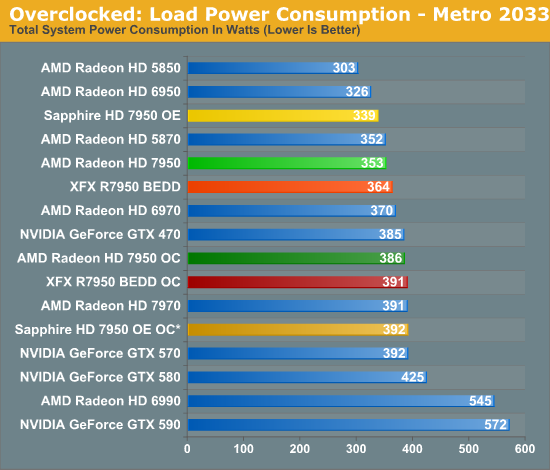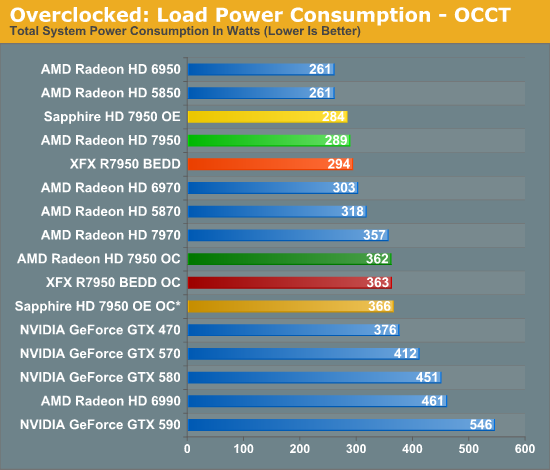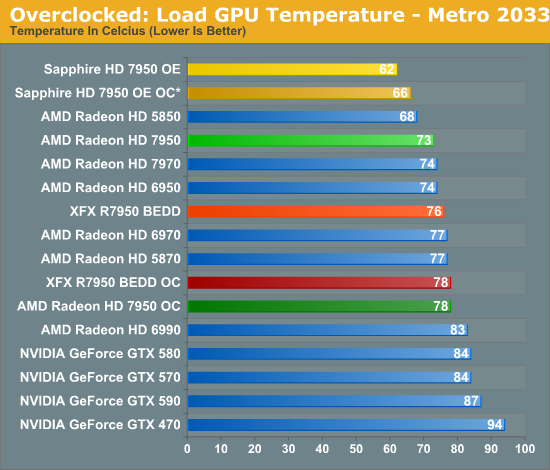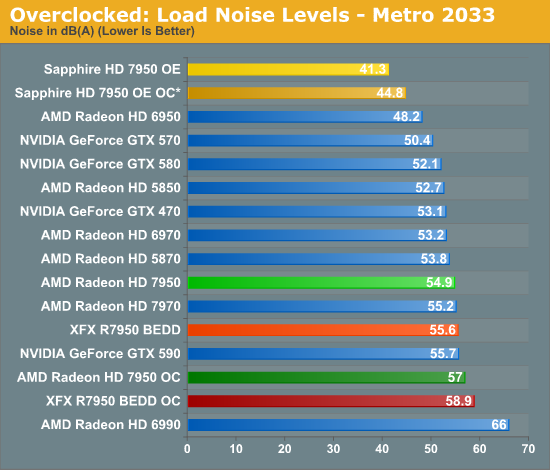AMD Radeon HD 7950 Review Feat. Sapphire & XFX: Sewing Up The High-End Market
by Ryan Smith on January 31, 2012 9:02 AM ESTOverclocking: Power, Temp, & Noise
In their marketing materials AMD is heavily pushing overclocking, and they have good reason to. With the 7970 we’ve established that Tahiti has quite a bit of overclocking headroom, and as the 7950 is clocked lower by default this opens up that headroom even further. Realistically AMD’s binning process means that the best clocking Tahiti GPUs are going to be allocated to the 7970 unless they have failed shaders, but even with that there’s quite a bit of potential on paper.
As with overclocking the 7970, our goal overclocking the 7950 is to see how much you can get for free; that is without any voltage adjustments. AMD’s reference PCBs are not particularly overbuilt for overclocking—cards like that will come later—so sticking to the reference voltage is the safest option, not to mention the easiest. With the 7970 we were able to get 200MHz (22%) overclocks without any voltage adjustment, and we’re hoping for the same out of the 7950.
With that said, we quickly ran into a wall on one card: the Sapphire 7950. Sapphire’s low VID of 0.993v may be great for temperature and noise at stock, but it’s not doing overclocking any favors. We only hit 950MHz at that voltage. As the Sapphire was the odd man out—every other card was at 1.093v—we did end up overvolting the Sapphire to 1.093v to see what it was capable of when put on similar footing as the rest of our cards.
After bringing up the voltage of our Sapphire card, all of our 7950s ended up overclocking to very similar levels. Our Sapphire and AMD cards topped out at 1025MHz core, a 225MHz (28%) overclock over a stock 7950 and a 125MHz (14%) overclock over the Sapphire’s factory overclock, while our XFX card reached 1050MHz, a 150MHz (17%) overclock beyond XFX’s factory overclock. Meanwhile the memory clocks on all of our cards topped out at 5.8GHz, beyond which we’d start seeing performance regressions from error correction on the memory bus.
| Radeon HD 7950 Overclocking | |||||
| AMD Radeon HD 7950 | Sapphire HD 7950 Overclock Edition | XFX R7950 BEDD | |||
| Shipping Core Clock | 800MHz | 900MHz | 900MHz | ||
| Shipping Memory Clock | 5GHz | 5GHz | 5.5GHz | ||
| Shipping Voltage | 1.093v | 0.993v | 1.093v | ||
| Overclock Core Clock | 1025MHz | 1025MHz | 1050MHz | ||
| Overclock Memory Clock | 5.8GHz | 5.8GHz | 5.8GHz | ||
| Overclock Voltage | 1.093v | 1.093v | 1.093v | ||
As you can imagine, with such similar overclocks, gaming performance on all 4 cards ended up being very similar. So we’ll get to gaming performance in a minute, while we’ll start with power, temperature, & noise.


Even though we’re not increasing the voltage on our AMD and XFX cards, merely overclocking them and raising the PowerTune limit to avoid throttling does drive the power consumption up. As is typical with heavily overclocked cards, overclocking quickly drives up power consumption and the 7950s are no exception. After overclocking power consumption is almost identical to the stock 7970, so while you can get 7970 performance you still need to pay the price with 7970 power consumption. Meanwhile it’s interesting to note that even with the extra 0.1v we’ve given the Sapphire card its final power consumption is only ever so slightly higher than the other 7950s, proving that voltage is the great equalizer in this case.


With the increase in power comes an increase in temperatures. The Sapphire card still does very well here staying in the low 70s even under OCCT, while the reference and XFX cards hit the high 70s under Metro and mid 80s under OCCT. As we’ve yet to really ascertain what the thermal limits are for Tahiti, it’s not clear whether there’s too much thermal headroom left for the GPU, particularly under OCCT.


Last but not least we have load noise. The Sapphire card is once more a stellar performer, and we still can’t get it above 50dB even with OCCT. Unfortunately the XFX 7950 BEDD has its biggest fallout yet—it may be able to overclock well, but at 64dB under OCCT the performance isn’t going to be worth the immense amount of noise it creates to move enough air to keep the GPU cool.










259 Comments
View All Comments
xeridea - Tuesday, January 31, 2012 - link
Tru Datxeridea - Tuesday, January 31, 2012 - link
But not as bad as the Obamination we are in today.bji - Tuesday, January 31, 2012 - link
Which is better than the Bush clusterf** we were in yesterday ...Sabresiberian - Tuesday, January 31, 2012 - link
Too bad we can't actually blame stupidity on some drug that we can prevent people from smoking.;)
dagamer34 - Tuesday, January 31, 2012 - link
So you want to wag your finger at AMD for trying to make money when Nvidia has decided not to show up for a few months? Everyone knows that competition drives lower prices and right now AMD doesn't have any at the truly high end. If you want the parts now, you can pay up or wait. It's that simple.I am actually glad AMD is competing at the truly high end again because it shows confidence in their products. Confident products = bolder designs in the long term.
chizow - Tuesday, January 31, 2012 - link
Actually I've been saying for years AMD missed an opportunity to profit by mispricing their RV770 badly. Ever since that time they've been trying to dig themselves out of the pricing mistake they caused, because as a direct result, Nvidia dropped their flagship single-GPU prices to $350-400 for the 2nd tier and $500 for the top single gpu. Since AMD's subsequent parts have always trailed Nvidia's same-gen parts, they were obviously forced to price their cards according to Nvidia's performance, which generally meant $400 or less.The problem is that SI offers none of the performance and value you would expect from a next-gen part, nor does it raise the bar for price/performance. It only manages to keep the status quo using last-gen metrics and the 7950 is direct proof of this. Its roughly the same price and performance as the GTX 580, which would've been great if this were 2010 when the GTX 580 launched, but its 2012 now.
arjuna1 - Tuesday, January 31, 2012 - link
leave it to an nvidia fanboy to twist facts around as needed to put nvidia on top.chizow - Tuesday, January 31, 2012 - link
I didn't say Nvidia was on top...But honestly, as an ATI fan take a look at the 6970 results compared to the 7950 and then ask yourself if you really think the 7950 is worth the price at $450-500 compared to the $300-350 for a 6970....
I mean if you thought the 6970 was a great deal compared to the GTX 580 how on earth could you think the 7950 is some amazing bargain some 14 months later?
Galidou - Tuesday, January 31, 2012 - link
OMG and you just realized that? Welcome in 2012, you hav ebeen sleeping for the last 20 years?!?Video card manufacturers have done that a thousand times before... Nvidia and Ati with their rebranding and next gen higher priced than last gen for the same performance... The top segment was never meant to be performance/price top of the chart.... OMG.
So by listening to what you said from the beginning, anything below gtx 580 is useless, because you can find last gen video card lower priced for more or same performance, because of the next-gen price premium... HELLO!?! wake up...
You can find gtx 480's at a way lower price than gtx 570's on the bay for about the same performance...
You can find radeon 4870 about half the price of 6770's for about the same performance....
And so on....
chizow - Tuesday, January 31, 2012 - link
I don't think you understand that in your attempt to discredit my point, you've actually completely validated it.Yes, historically when a new part releases it compresses prices and forces older last-gen parts to drop in price as the new price:performance metrics dictate a drop in price with the next-gen level of performance.
None of this is occurring with SI because AMD has priced this part exactly where its performance lies because they are basing this on last-gen metrics. If anything, lower tier parts are probably UNDER priced relative to performance compared to SI and have no reason to drop in price.